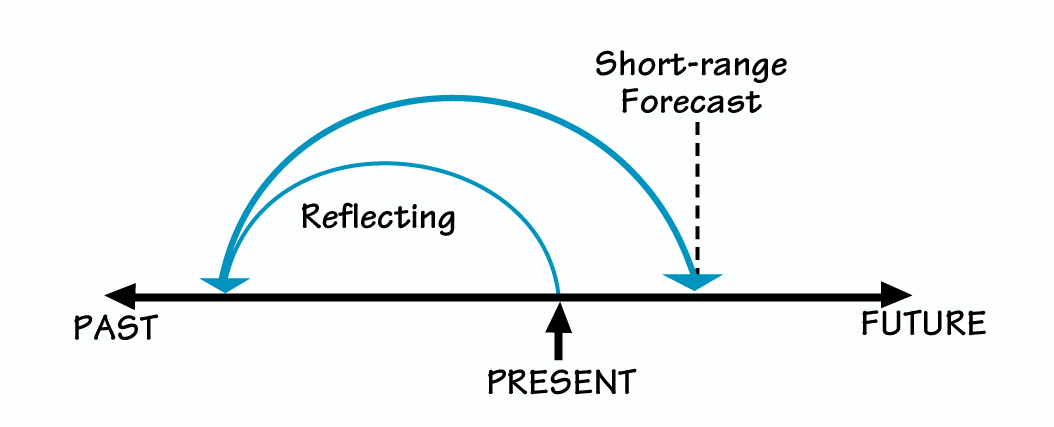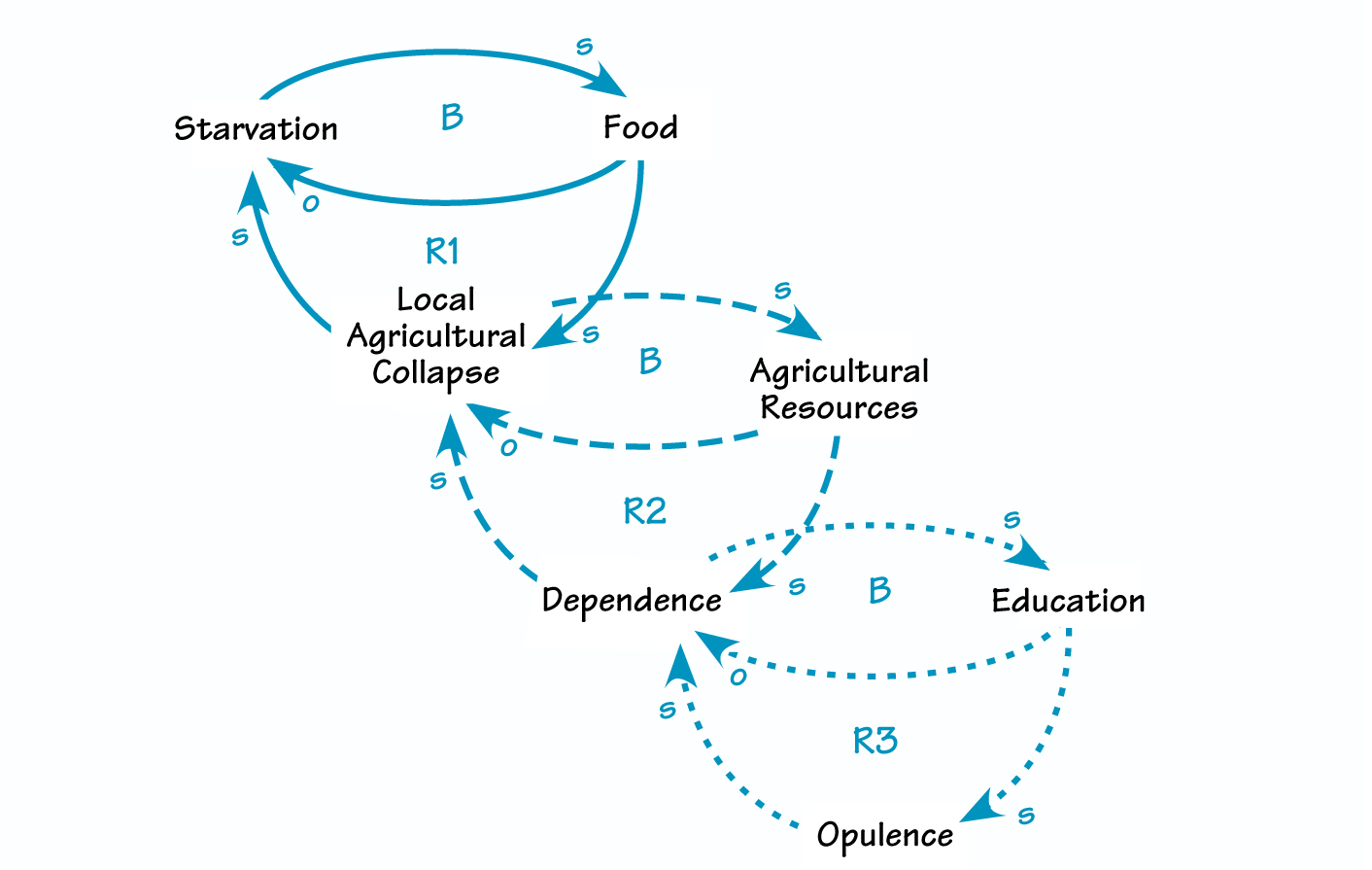Good leadership constantly requires a careful, ongoing evaluation of a vision of the future to which one can navigate. Many leaders are guided by the mechanistic world-view that projects a future horizon from the consciousness of our past—a forecast. This approach of forecasting holds serious limitations that prevent us from predicting the distant horizons. This article outlines the three horizons for our journey into the future. To co-evolve synergistically and harmoniously with the emerging future, we need to steer at three levels of consciousness. The first two levels project the forecast of the first horizon and the foresight of the second horizon, respectively. The third level is the most challenging. It requires us to “be in the present” to enable us to foreknow the distant future. These trajectories to the three horizons are not separate or sequential. They are complimentary, iterative, and recursive.
TEAM TIP
Divide a group into three teams and ask each team to develop one time horizon (first, second, or third). Then have the three teams bring their models together, with the first horizon nested in the second, and both nested in the third. Is the outcome a plausible map of an emerging future? If so, what are the implications for your organization? If not, why not?
- The First Horizon: Our past consciousness projects the forecast of the immediate future. Past becomes the stimulus for the future. It resides in the realm of mechanistic worldview and logical analysis—the logos—left-brain dominance. It is guided by problem-solving intervention.
- The Second Horizon: Insight or intuition, drawn from our mythic past—the collective unconscious—projects the foresight of a distant horizon. It resides in the holistic paradigm—the right-brain dominance and the mythos. It is facilitated by the interplay of polarities and paradoxes.
- The Third Horizon: Foreknowledge of the distant future can be experienced by being in the present—contraction of time and “self” (in humility), and expansion of “self” (in compassion). This resides in the co-evolutionary paradigm and mystical realm—the mystikos. It can be facilitated through an authentic dialogue.
This article will describe the philosophical and theoretical underpinnings of the three strategies for developing the three horizons. Each of the interventions proposed requires an appropriate catalytic environment for its fruition. Some of them include metaphors, art, music, humor, story-telling, and dialogue.
FORECASTING THE IMMEDIATE FUTURE

Projections of the past into the future often make us repeat our past mistakes or limit us to past successes. As Einstein pointed out, a problem cannot be solved by the same consciousness that created it in the first place.
First Horizon
Greek philosophers of the seventh century B. C. made sense of their external world through reasoning and logical analysis—the logos. This tradition marks the genesis of Western scientific tradition embracing observation, rationalism, and naturalism. It seems that the influence of Greek philosophy and classical science (Newtonian physics) has given us an enduring legacy of mechanistic thinking. With our problem-solving worldview shaped by our mechanistic thinking of cause-and-effect, we fix problems in anticipation of a quick desired future. But this approach has many shortcomings:
Shackled to the Past. . We reflect on the past and project it into the future to give us a short-range forecast as shown in “Forecasting the Immediate Future.” Projections of the past into the future often make us repeat our past mistakes or limit us to past successes. At best, it can provide us with a limited forecast of the immediate future. For example, today’s weather may give us some indication of what one may expect over the next few days, but not in the distant future.
World of Chaos. Isaac Newton’s laws of motion have enabled us to predict fairly accurately the location and the movement of the celestial bodies. But their application to complex situations in our turbulent environment such as those encountered in our social, political, and economic domains is inapt. The world of chaos carries the potential for unexpected amplification of weak signals, popularly referred to as the butterfly effect. For example, a single terrorist proclamation can precipitate a cascade of events that impact the entire economy.
Pitfalls in “Fixes That Fail” Archetype. In analyzing the dynamics of systems, we frequently use the “Fixes That Fail” archetype as a lens to explore the unintended consequences of our problem-solving actions. But if we do while entrenched in the mechanistic paradigm, such analysis can be accompanied by pitfalls:
- Stuck in a reactive mode, we generally rush in to fix the problem without adequately investigating the root cause.
- Our choice of unintended consequences can itself be driven by our problem-solving mindset. We proactively look for potential problems that will need to be solved, leading to a self-fulfilling prophecy.
- When we explore the unintended consequences, we rarely look for possibilities of good outcome or opportunities; nor do we distinguish between the consequences that we will need to adapt to and those we could influence.
- Every unintended consequence has its own expectancy of occurrence. Some are expected to occur in the immediate future and some later. Thus the ability to foresee the distant future becomes imperative if we want to have a broad systemic view of the whole.
- In certain cases, the so-called unintended consequences may in fact be undeclared “intended consequences,” in the hope of fulfilling some political agenda.
- When we notice each detrimental consequence, we treat it as a problem and proceed to fix it, which generates its own set of unintended consequences, each of which becomes a problem. Thus we launch an endless cycle of problems, which all proliferate from one single problem.To illustrate this proliferation, let’s examine the problem of starvation in a given country. Our immediate reaction would rightly be to send food donations. But such action can be followed by myriad unintended consequences. They include collapse of local agriculture, increase in population, corruption, dependency, and so on. Each of these unintended consequences represents a problem, which, if solved in the reactive mode, would precipitate its own set of unintended consequences. Thus a single problem can generate chaos and disorder. Each unintended consequence exacerbates the problem, creating a paradox. This is illustrated in “Proliferation of Problems and Paradoxes in a Quick Fix.”
- As every unintended consequence exacerbates the original problem, it represents a paradox. Since each one of the unintended consequences becomes a problem, with its potential to present a paradox when solved, a whole array of paradoxes can precipitate from a single problem. Can such an assortment of paradoxes liberate us from the bondage of the mechanistic paradigm and serve as an intuitive framework for exploring future scenarios? To sound a note of caution, awareness of the paradoxes by itself cannot stimulate the shift, unless catalyzed by an enabling environment.
- In the above analysis, we, sadly, do not see the problem as universal suffering of humankind but suffering of the “other,” thereby stripping us of a sense of compassion. Our actions then tend to be driven by self-interest, under the cloak of some acceptable ideology such as charity, goodwill, freedom, democracy, and so on. Systems thinking, by its very designation, implies thinking conditioned thoughts and is unmindful of the complexity of the human psyche, the same way the proverbial fish is unaware of its ambient water. Otto Scharmer lucidly describes this unawareness as a blind spot in social sciences.
Second Horizon
Our ancestors constructed legendary narratives of supernatural origins gods, goddesses, demons, and so on to make sense of changes in their external environment. They internalized the myths by coacting with the gods and demons in the cosmic theater. Their narratives and accompanying rituals permeated into the very core of their being—their psyche. The Greeks call it the age of mythos. It existed in almost every ancient culture and civilization.
PROLIFERATION OF PROBLEMS AND PARADOXES IN A QUICK FIX

Consider a starving nation that receives food donations. In the short term, the intervention relieves the starvation. However, unintended consequences exacerbate the “problem.” Conventional Metaphor: Food relieves starvation. Paradox: The more we feed, the greater the starvation.
- Carl Jung concluded that mythology was a universal phenomenon of the collective unconscious—an archetypal field of the human psyche.
- Albert Einstein contended:, “The intellect has little to do on the road to discovery. There comes a leap in consciousness, call it intuition or what you will, and the solution comes to you and you don’t know how or why.”
- Can we draw intuition from our collective unconscious to foresee the future? We can delineate logos, mythos, and mystikos on a continuum of time and beyond, ranging from chronos to kairos. Each phase holds a specific quality and intensity of creative work. Along this continuum, there is a phase in which ones passion for creative work evokes a sense of distortion of time.
- When we want to bring about a quantum shift in our consciousness to meet a new challenge, we can spark creativity through intrinsic motivation that causes a psychological distortion of physical time.
- Mihaly Csikszentmihalyi called it the flow. In this state, the creator gives total attention to what is being created with exclusion of all distractions. Time flies. Every moment of the journey becomes its destination.
- The experience of a creative flash (Ah-ha) is arguably more intuitive than analytical (right-brain activity, according to Ned Herrmann). Therefore if we can foster a creative environment, it can stimulate the intrinsic motivation and intuition necessary for foreseeing the distant future.
The Third Horizon
There is an existential dimension of human faculty, the mystikos a state, in which one can experience higher intelligence. Through such transcendent awareness, we can gain a holistic foreknowledge. The fifth-century Roman philosopher Boethius described such awareness as totum simul, meaning the perception of the whole in the same instant. In this state, we experience the “now,” as lucidly expressed by William Black in his famous verse:
To see a world in a grain of sand, and heaven in a wild flower; Hold infinity in the palm of your hand, and eternity in an hour.
Though mystikos is not something we experience everyday, a collective ascent to a higher metaphor—combined with a fitting narrative and dialogue—may help to compress time sufficiently to invoke the glimpse of the unknown-unknown.
Can we draw intuition from
our collective unconscious to
foresee the future?
Process for Navigating the Emerging Future
Driving a car provides a simplistic and heuristic metaphor to illustrate these three aspects of the journey:
- As we drive along a meandering road, an awareness of a linkage between what we have passed to what is passing—can give us a forecast of the emerging future the first horizon. It requires a regular scan through the rearview mirror. It represents “one path, one journey.”
- Sense of the second horizon requires intuition about the direction we want to take. It represents making a choice from several plausible scenarios. Our adaptive competence would guide our choice of a viable path.
- Finally, we enter a terrain that has no path. It is a “pathless journey” of discovery. It requires us to be in the “now,” as we adapt to the terrain and influence the creation of a path to the third horizon.
There are a number of ways in which this process can be designed and implemented in an organization, bearing in mind the importance of creating an appropriate enabling environment described above. In one such design, we can divide a group into three teams. Each team could be asked to develop one horizon. The three teams can then get together to carry out a conversation such that the three findings can form a set of Russian Matriôcha dolls: the first horizon nested in the second, and both nested in the third. Thus, they would end up with a plausible map of an emerging future. Such a map would require continual monitoring to ensure co-evolution with the rapidly changing environment in which it exists.
